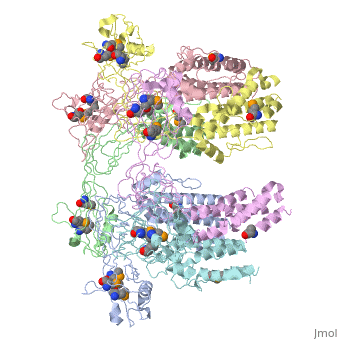Flagellar proteins: Difference between revisions
Michal Harel (talk | contribs) No edit summary |
m Flagellar hook-associated protein moved to Flagellar proteins: requested by Editor |
||
| (4 intermediate revisions by 2 users not shown) | |||
| Line 4: | Line 4: | ||
== Function == | == Function == | ||
The ''' | The '''Flagellar proteins FlgK''' (or HAP1), '''FlgL''' (or HAP3) and '''FliD''' (or HAP2) are part of the bacterial flagellum <ref>PMID:2193164</ref>. These 3 proteins seem to be located at the claw-shaped end of the flagellum and play an essential role in filament formation. '''Flagellar protein FlgA''' is a chaperone protein required for P-ring assembly in bacterial flagella<ref>PMID:27273476</ref>. For details see [[Samatey/2]]. | ||
</StructureSection> | </StructureSection> | ||
== 3D Structures of | == See Also == | ||
* [[Flagella, bacterial]] | |||
* [[Flagellar filament of bacteria]] | |||
* [[The Bacterial Flagellar Hook]] | |||
* [[Samatey/4|Complete Flagellar Hook Structure]] determined by cryo-EM in 2016. | |||
* [[Samatey/3|Structural insights into bacterial flagellar hook similarities and specifities]] (2016). | |||
* Other recent reports on structures of flagellar components at [[Samatey]]. | |||
== 3D Structures of flagellar proteins == | |||
Updated on {{REVISIONDAY2}}-{{MONTHNAME|{{REVISIONMONTH}}}}-{{REVISIONYEAR}} | Updated on {{REVISIONDAY2}}-{{MONTHNAME|{{REVISIONMONTH}}}}-{{REVISIONYEAR}} | ||
| Line 21: | Line 29: | ||
[[5xlk]], [[5xlj]] – FliD D2-D3 domain – ''Serratia marcascens''<br /> | [[5xlk]], [[5xlj]] – FliD D2-D3 domain – ''Serratia marcascens''<br /> | ||
[[5fhy]] – FliD D2-D3 domain – ''Pseudomonas aeruginosa''<br /> | [[5fhy]] – FliD D2-D3 domain – ''Pseudomonas aeruginosa''<br /> | ||
[[3vki]], [[3vjp]], [[3tee]] – StFlgA <br /> | |||
[[3frn]] – FlgA – ''Thermotoga maritima''<br /> | |||
== References == | == References == | ||
Latest revision as of 13:16, 1 January 2018
FunctionThe Flagellar proteins FlgK (or HAP1), FlgL (or HAP3) and FliD (or HAP2) are part of the bacterial flagellum [1]. These 3 proteins seem to be located at the claw-shaped end of the flagellum and play an essential role in filament formation. Flagellar protein FlgA is a chaperone protein required for P-ring assembly in bacterial flagella[2]. For details see Samatey/2.
|
| ||||||||||
See AlsoSee Also
- Flagella, bacterial
- Flagellar filament of bacteria
- The Bacterial Flagellar Hook
- Complete Flagellar Hook Structure determined by cryo-EM in 2016.
- Structural insights into bacterial flagellar hook similarities and specifities (2016).
- Other recent reports on structures of flagellar components at Samatey.
3D Structures of flagellar proteins3D Structures of flagellar proteins
Updated on 01-January-2018
4ut1 – FlgK – Burkholderia pseudomallei
2d4x – StFlgL – Salmonella typhimurium
2d4y – StFlgK
5gna – StFlgK residues 401-467 + FliT
5h5t – StFliD D2-D3 domain
5h5v – EcFliD D1-D2-D3 domain – Escherichia coli
5h5w – EcFliD D2-D3 domain
5xlk, 5xlj – FliD D2-D3 domain – Serratia marcascens
5fhy – FliD D2-D3 domain – Pseudomonas aeruginosa
3vki, 3vjp, 3tee – StFlgA
3frn – FlgA – Thermotoga maritima
ReferencesReferences
- ↑ Homma M, DeRosier DJ, Macnab RM. Flagellar hook and hook-associated proteins of Salmonella typhimurium and their relationship to other axial components of the flagellum. J Mol Biol. 1990 Jun 20;213(4):819-32. PMID:2193164
- ↑ Matsunami H, Yoon YH, Meshcheryakov VA, Namba K, Samatey FA. Structural flexibility of the periplasmic protein, FlgA, regulates flagellar P-ring assembly in Salmonella enterica. Sci Rep. 2016 Jun 7;6:27399. doi: 10.1038/srep27399. PMID:27273476 doi:http://dx.doi.org/10.1038/srep27399
